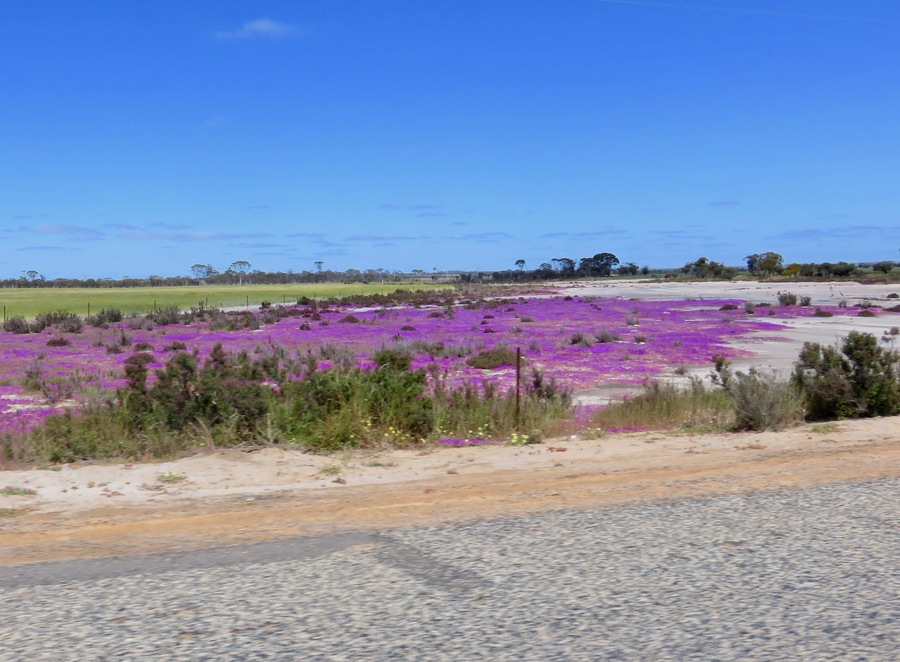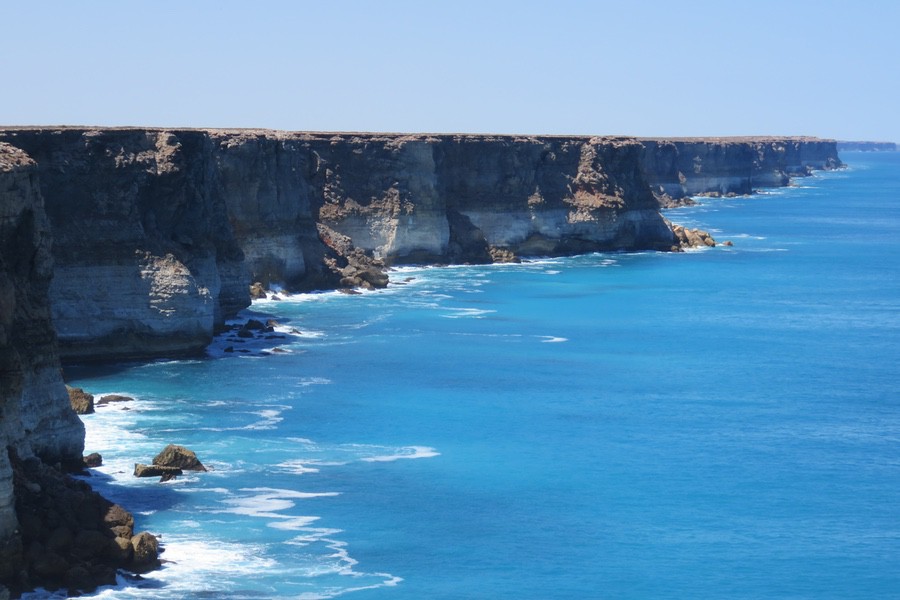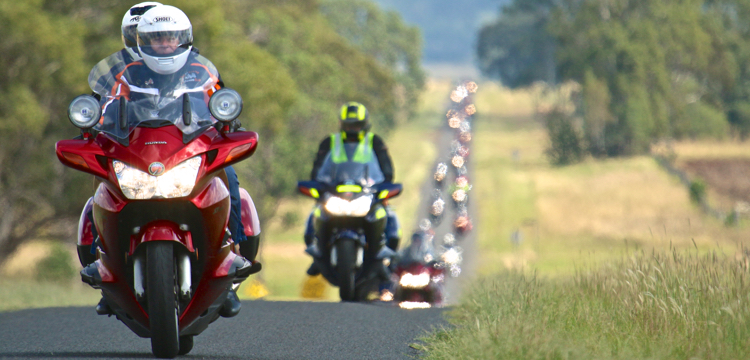
If you missed issue 163 you won’t have read Chris Day’s great article about crossing Australia…
The sign at Nullarbor Roadhouse warned of kangaroos, wombats and camels on the road ahead. That’s right, camels. I was last here in 1975 when I drove from Sydney to Perth and the Eyre Highway across the Nullarbor was unsealed for 400km from near Ceduna in South Australia to the Western Australia border. It was a rough gravel road with potholes, horrible corrugations and sharp limestone rock edges that destroyed tyres. There were only a couple of widely spaced fuel stops, so you needed to carry fuel and water.
These days the Eyre Highway is a wide, two-lane road with an excellent bitumen surface all the way. However, having just ridden two-up for 2000km from Perth to get here, and having the same distance to go to Sydney, we appreciated that riding across Australia
is still a challenge.
WEST TO EAST
Having shipped the Honda ST1300 from Sydney to our son’s place in Perth and flown over, we headed off in mid-October to ride home. We rode up into the Perth Hills on a scenic and twisting road before heading east on a good road to the wheat belt town of Hyden, 350km away, for our first night. Wave Rock is just outside town and is a curved piece of granite 110m long and 30m high with amazing colours on its surface. It really does look like a giant wave and was worth seeing.
WA is called the Wildflower State and as we travelled south to Ravensthorpe there were carpets of purple, red and yellow everywhere. At Ravensthorpe, we took a 10km there-and-back detour to the small settlement of Hopetoun on the coast. This is an out-of-the-way place with pristine white beaches and blue water located on the eastern edge of the Fitzgerald River National Park. I was last there at the end of 1975 when three of us from Albany rode our trail bikes from Bremer Bay to Hopetoun through the bush, following the route of the old overland telegraph line and camping along the coast on the way. I can remember riding and pushing my loaded-up Suzuki 185 through soft, sandy tracks on a hot afternoon for the last few kilometres into Hopetoun and then downing one of the nicest, coldest beers I had ever tasted as we collapsed in the shade of the pub. As my wife so kindly reminded me, that was a lifetime ago.
THE LAST OF THE CIVILISATION
After a 500km day we arrived in Esperance, home to one of the most scenic pieces of coast in Australia. We stayed at a motel right on the harbour for two nights with a pub next door that did excellent pizza for dinner. We spent a day looking around — the morning walking around the town and harbour and then the afternoon doing a 35km return ride along a nice bike road that hugs the coastline. We stopped frequently to take in the views of this beautiful coastline that boasts quiet beaches of pure white sand, rocky headlands, water that is turquoise blue and many islands off-shore that make up the Archipelago of the Recherche. With a population of over 14,000, Esperance would be the last town of that size we would encounter until we reached Port Augusta in SA — almost 2000km away.
THE NULLARBOR
The road across the Nullarbor runs 1200km from Norseman in WA to Ceduna in SA. From Esperance, it was 200km due north to Norseman, initially through wheat country and then scrubby woodland with several blue lakes with salt edges. After fuelling up at Norseman we turned onto the Eyre Highway, pointed the bike east at the horizon and headed off across the Nullarbor.
Although Nullarbor means “no trees”, the actual treeless part of it doesn’t start until Nullarbor Roadhouse in SA and we christened this part of the route the “Multiarbor” as there were lots of trees.
There were also lots of emus and they were hard to
see on the side of the road.
More than 10,000 miles from Cape Canaveral and 200km from Norseman is a space museum, more commonly known as the Balladonia Roadhouse. Balladonia became famous in 1979 when the out-of-control NASA Skylab space station broke up and crashed to earth with debris landing nearby. A 4m x 2m chunk of Skylab recovered from the bush is displayed in a small museum. We stayed in one of the cabins we had reserved ahead of time rather than chancing it on the day and finding nothing available. Out on the Nullarbor, it is a long way to travel to find accommodation.
NINETY MILES WITHOUT A BEND
Soon after leaving Balladonia, we were on the Ninety Mile Straight, the longest, straight stretch of road in Australia and one of the longest in the world. For a motorcyclist, 147km of dead straight road usually won’t excite you too much but, as with so much on the Nullarbor, it’s all part of the experience. The Royal Flying Doctor Service uses the Eyre Highway for medical retrievals and we saw three airstrips marked out on the road along here. There were lots of dead kangaroos lining the side of the road with many carcasses on the roadway itself. We didn’t see any kangaroo activity during the day as the carnage occurs mainly at night.
Although travelling on flat countryside, you don’t realise you’re on an escarpment until just before Madura Roadhouse, when you suddenly encounter a few curves and then descend the Madura Pass onto the coastal plain. From the top of the pass you can see the coast in the distance and the edge of the escarpment retreating inland. It stays well inland until rejoining the coast near Eucla, where it forms cliffs all the way to the head of the Great Australian Bight. At the bottom of the pass, Madura Roadhouse is tucked off the road in the bush and we stopped there for lunch. We tried to eat outside but gave up and surrendered our food to the swarms of flies.
We encountered a stiff head wind at this stage and fuel consumption increased. The longest distances between roadhouse petrol stations were 192km from Norseman to Balladonia, 182km from Balladonia to Caiguna and 188km from Border Village to Nullarbor. Although the ST1300 has a large tank with a good range, we stuck with our “keep the tank full” motto
and filled up whenever we could.
After a 460km day, Mundrabilla Roadhouse was our stop for the night. To describe our room as “basic” was being kind. Cracks and holes in the window were covered in tape, you couldn’t swing a cat inside and the furniture was pretty rough. At the time, our daughter was deployed to the Middle East with the army and living in a re-purposed shipping container. We thought her accommodation was probably better than ours. However, we were out on the middle of the Nullarbor and so having a roof and four walls, being able to sleep in a bed (which was actually very comfortable), have a shower in desalinated water and also a flushing toilet was the height of luxury. That was how I explained it to Carmen anyway.
CLIFFS AT THE BIGHT
At Eucla the next day, we decided not to play dirt bike with the heavily laden ST and visit the ruins of the old overland telegraph station in the sand dunes. After Eucla, the road follows the coast of the Great Australian Bight for quite a way and there are several lookouts with spectacular views of the cliffs. Known as the Bunda Cliffs, they are sheer drops of 80 to 120m from the tabletop flatness of the plain down to the surf below and they extend in an unbroken line east to the horizon. The Southern Ocean was the bluest of blues and seeing the cliffs was one of the highlights of the trip.
Our last night on the Nullarbor was spent in one of the modern and comfortable motel rooms attached to Nullarbor Roadhouse. The roadhouses on the Nullarbor have to use diesel generators and solar panels for their electricity and use desalination plants to convert artesian water into drinking water. Everything has to be transported long distances by truck so can be expensive to buy. However, the meals at the roadhouses were good and there was great camaraderie amongst the travellers. There weren’t many bikes on the road and we met only a handful of other motorcycle tourists. No one was game to ride at night once they saw all the dead kangaroos. Plus there was that sign warning of wild camels.
Heading east from Nullarbor Roadhouse we were on the treeless plain that gives the Nullarbor its name. At one stage we pulled off the road, turned off the motor and got off the bike to just look and listen. It was absolutely silent out there until we heard the sound of an approaching vehicle in the distance. Then it was gone and we were back in the silence. You can look to the horizon in every direction and see nothing but red earth and saltbush under the dome of a blue sky. It’s a harsh environment, but we found it beautiful to look at. It also makes you realise how vast and empty this part of Australia is.
Nundroo was the last roadhouse on the Nullarbor and after that we were back in farming country for the first time since just north of Esperance. We stopped at the small town of Penong to have a look at its famous outdoor windmill museum. Penong had one pub, one service station and one general store that stocked everything. The servo was closed for renovations so there was no fuel available, but the shop was open and my coffee-deprived wife had her first cappuccino since Esperance nearly 1400km ago. Then it was on to Ceduna to stay at a motel on the edge of the bay. With a population of 2000, Ceduna looked like a big city after the Nullarbor.
We spent a day looking around the coast and stayed in picturesque Streaky Bay overnight. This part of Australia is renowned for its seafood and oysters and dinner at the only pub in town was excellent. As we came outside after dinner, it started hailing and then the sun came out to reveal a huge rainbow over the bay. What a pretty place it was. We decided that we would have to return to the Eyre Peninsula one day and explore the whole lot of it. From Streaky Bay it was a 400km ride to Port Augusta via Poochera and Kimba, where we stopped at the Big Galah and had lunch at the Half-Way Across Australia Bakery. From Port Augusta, there are multiple ways to return to the east coast. We headed down to Adelaide to visit friends and explored picturesque McClaren Vale where the twisty roads allowed the first real cornering since the Perth Hills.
ON TO SYDNEY
Our route home to Sydney took us through the Barossa Valley and Renmark in SA, across the northern part of Victoria to Mildura and then across the border back into NSW. In those pre-COVID days, crossing a border into another state was just a matter of riding past the welcome sign without a border declaration pass to be seen anywhere. In fact, if you missed the welcome sign you would know you were back in NSW from the immediate deterioration in the road surface.
There had been flooding in south-eastern Australia over the previous weeks but we were blessed with fine weather. We crossed the bridge into Hay over a swollen Murrumbidgee and roads and parks on the river’s edge were under water. Luckily, the water level was dropping so we would not get trapped overnight.
Between Hay and Narrandera, floodwaters came right up to the side of the road in places. In Narrandera, the petrol bowsers at the service station were still wrapped in layers of plastic and sand bagged around their bases for protection from when the floodwaters had been rising. We stayed with a friend in the small Riverina town of Coolamon for two nights and then travelled north-east through green and gold canola country on the Olympic and Burley Griffin Ways. This was a nice ride, with plenty of curves to make up for the straight stretches over west. Then it was up the Hume Highway and back into the gridlock of Sydney after a 4400km ride across the continent.
What is our lasting memory of the trip? It was the ride across the Nullarbor. People may tell you it’s boring and not to bother. But they have probably never done it.









